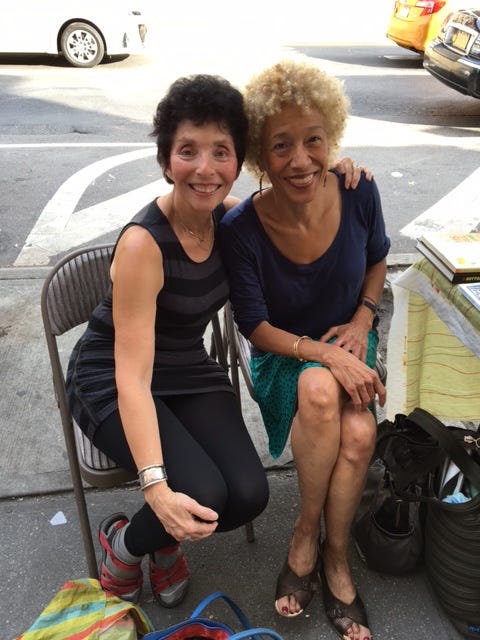Richard and I were on the subway, heading downtown. Everyone was on their phone. Me too. Richard was looking around. There was an ozone smell in the air, and I realized I missed the smell of subway and the gallery of faces, every kind of face in the universe in every subway car.
Across from us, a few seats down, was a young man looking straight ahead. He was wearing a white t-shirt, and his arms were what Michelangelo would have looked at and said, hallelujah. His shoulders were squared. He was Homo erectus. I said to Richard, “I’m going to tell that man he is my role model for the rest of my life.” Richard said, “Don’t disturb him.” I said, “Everyone talks to strangers on the subway.” He gestured around and said, “Not anymore.”
My mother talked to strangers her whole life. In subways, on buses, on the street, in restaurants and shops. She was lonely. It was a way for her to be less alone and enter the world. Being beside her could be weird sometimes. Then, at a point I can’t place, I liked remembering her this way. I had already become her, so there’s that.
I walked over to the young man. He was listening to music on ear pods. I said, “Excuse me.” He popped out a pod. “You have changed my life. You have the best posture I have ever seen, and I am going to model myself on you from now on.” He smiled, throwing back his head a little. He had perfect white teeth to match his perfect posture. We chatted a bit longer, and I returned to my seat. I said to Richard, “He was happy. I made him happy.” I could see Richard wanting to say, “Not as happy as you think you made him,” but we were having a good time together in the city, and maybe he wasn’t sure about the amount of happiness I had produced.
The three of us got off at 14th Street and bid each other a good day, as we bounded up the stairs and moved off in different directions. Five hours passed. Richard and I did what we did, and the young man did what he did, and then this happened. The thing I am about to tell you happened because it is the kind of thing that can happen in New York if the molecules are excited in a way that can’t be predicted or measured.
Richard and I went to Art Bar on 8th Avenue near 13th Street to hook up with our friend Margo. Richard and I found seats in the back, and then I went to the bar, up front, to see if Margo had arrived. I could see her standing outside by the door, but as I passed people at the bar, there was the young man from the subway, still in his white t-shirt and Michelangelo arms. I went up to him and said, “We met earlier on the subway. What are the odds of our meeting again?”
He said, “Oh my god. This is crazy.” His was Lloyd. He introduced me to his boyfriend, Richard. This Richard said, “It’s the kind of thing that can only happen in New York.” I said, “Wait a minute,” and I went to get Margo. I introduced everyone around, and this Richard said, “You can know people your whole life and never run into them on the street, and here you two are accidentally meeting twice on the same day.”
It turned out Lloyd and Richard looked the way they did because they were dancers in the Martha Graham company. I said, “Margo is connected to the dance world,” and she mentioned that her sister Denise had run the Alvin Ailey school for many years. Lloyd said, “I studied with Denise!” I remembered that Denise had studied Graham technique and wondered if she’d influenced Lloyd in that direction. The three chatted on about the dance world, and I went to the other Richard to tell told him what was happening.
What was happening? Richard and I had met by accident years ago. What were the odds we would find each other at an artist colony in Saratoga Springs in 2006?
Remember in Casablanca when Humphrey Bogart spots Ingrid Bergman entering his nightclub? He says to the piano player, Doolie Wilson, “Of all the gin joints in the world, she has to walk into this one.” Those are slim odds, but Rick’s place is a wormhole where time bends. In the great scheme of things, he says at the end, sending Ingrid back to her husband, “Two people in love don’t amount to a hill of beans.” What he’s saying is they do. He’s saying love is the thing they are fighting for, and you can’t argue with Bogie, because, when you look at it, love is the tendency of the whole thing. Every living organism is composed of molecules that are not themselves alive but collectively produce a living thing. Every living thing is love that has taken on an animated form.
I wanted the day to mean something. Earlier, we’d walked along Thompson Street through Soho. Richard was drinking a Snapple, and I was looking around for myself on the streets, in the bodies and manners of girls who passed, in the look and sounds and smells of where another life had been lived, and I wasn’t there. It was thrilling. I shared a mandarin orange with a smiling young guy delivering cases of alcohol on a hand truck. That was me. Then and always. That was me, wheeling a hand truck during a catering gig.
I remember walking late at night in the subway. It’s 2 am, and I’m coming back from a party. I walk through a tunnel occupied with Jesus people. Giant posters depicting religious scenes line the passageway. A man is speaking loudly about salvation on a sound system, and music reverberates off the tile walls. I move along uninterrupted. No one thinks I can be saved.
I wanted the day to mean something, this collision of people and forces, and it did mean something. It made me feel connected to Margo, Denise, my mother, and to Richard—for floating along the streets with me for 18 years. Before I knew for sure we would be something, I saw us walking in New York and talking to strangers. I saw us walking on the savanna, looking for a femur bone to break and suck out the marrow. We were our primate ancestors, Lucy and Luke, sharing the bizarre occurrence of hearing voices in our heads. We were Lucy and Luke, inventing a third language, so we could speak to each other.
The bar and the train were every kind of skin color and sex. I breathed it in, the world we had made during our lives that is another word for freedom. I know we will outlast the people who want to end us. Because they are people who don’t know why they’re alive.
One day in the Lake District in England, Richard and I climbed stone stairs to a grand hotel and sat on a small sofa that looked over Lake Windermere. After a while, I became aware I was sitting on a mound of coins that had slid from the pockets of other people. I counted them. There was enough money to take us out for an Indian meal. No one cares how anything ends. People get Darwin wrong. It’s not the ruthless that survive. It’s the ones who adapt to change.
_____________________________________________________________
This stack is a labor of love
For you, for feminist thought, for literary publishing that answers to no censors or cultural hall monitors.
If the writing adds pleasure to your life, please take a turn at support with a PAID SUBSCRIPTION. It’s the only way the publication can continue.
I don’t have a paywall. I will never have a paywall.
____________________________________________________________
From Richard’s latest post on his Substack Every Twenty Minutes.
“When Richard asks what it’s like to live with a person with two different personalities, depending on the amount of glucose floating in his blood, I tell him it’s fine, most of the time. To me, most of the time, he is one person with fluctuating moods and abilities to function. I was hyper-alert when we met, and this has come in handy in our relationship. Maybe it’s the core saving factor in our relationship, not in a female nurse sense. More in the sense of someone is awake all the time, allowing the other person to sleep, like in The Invasion of the Body Snatchers, where, when you fall asleep, the pod people come and replace you with an empty replicant.”
To read the entire post, click here: richardtoon1.substack.com/p/it-aint-me
____________________________________________________________
Our last Zoom Conversation
on comic techniques is so far the most requested recording we have made. We talk about 8 comic techniques you can use in your writing, with concrete examples and prompts for practice. If you would like a link, please write to me at: lauriestone@substack.com.
The Next Zoom Conversation
Is on SATURDAY May 31 from 3 to 4 EST. To RSVP, please email me at: lauriestone@substack.com.
The Next Breakout Conversation
Is on Sunday June 1 from 3 to 4 EST, where you can speak about a project you are working on and receive feedback, please email me at: lauriestone@substack.com. There is a cap of 10 participants and an additional cost of $30.
More Extras for Paid Subscribers
If you would like to book time to talk one-on-one about a project you are working on or for guidance on gaining confidence and freedom in your writing, please email me at: lauriestone@substack.com.
If you would like to book time to talk one-on-one about STARTING AND GROWING a Substack publication please email me at: lauriestone@substack.com. I can help you through the software and approaches to gaining readers.
_________________________________________________________
A quick way to lend one-time support and attend the next Zoom:
Tip your server with a $4 coffee: ko-fi.com/lauriestone







This is exactly what I adore - and painfully miss - about New York. Like you, I am a compulsive talker to strangers. Once, a man leaned over to say I had the best posture he'd ever seen, and I had to confess I was wearing a back brace after being hit by a car. We ended up having dinner together. These moments don't seem to happen as often anywhere else. Love to you.
You are a tonic!
I too lived in Manhattan. And I too can tell stories of connections, but not as well as you do and certainly without your ability to expand the theme and find deeper resonance.